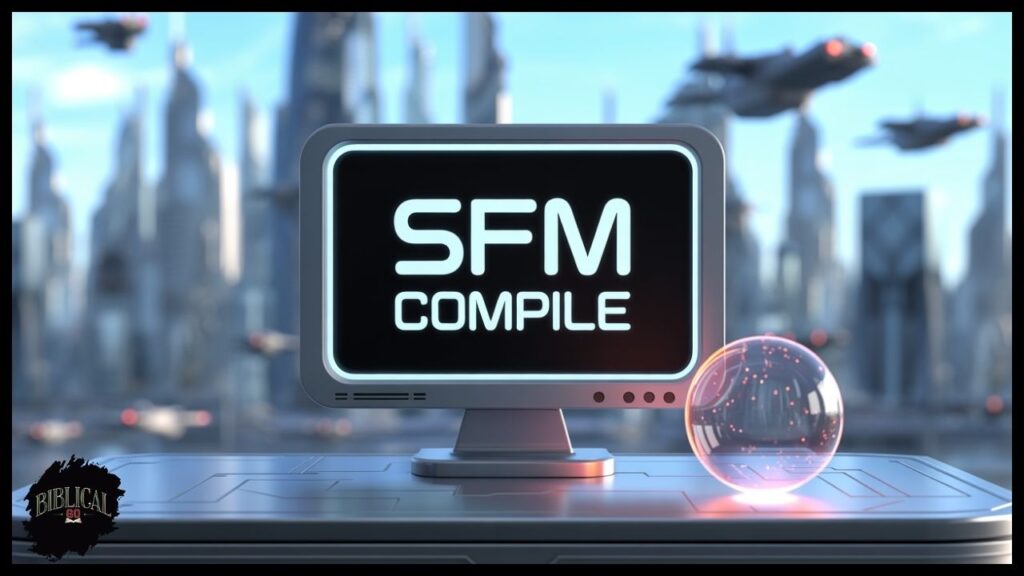Ever wondered why some Source Filmmaker animators create stunning, professional-quality content while others struggle with basic model imports? The secret isn’t artistic talent it’s mastering SFM compile.
This comprehensive guide will transform you from a frustrated beginner into a compilation expert who understands every aspect of the Source engine’s asset pipeline.
Why SFM Compile Determines Your Creative Success
SFM compile represents the bridge between raw 3D assets and usable animation elements. Without proper compilation knowledge, you’ll face endless errors, performance issues, and limitations that crush creative momentum.
The compilation process converts human-readable files like SMD and QC scripts into binary formats that the Source engine understands. Think of it as translating your creative vision into a language the game engine speaks fluently.
Most animators abandon Source Filmmaker because they can’t overcome compilation hurdles. But once you master these processes, you’ll unlock advanced techniques that separate amateur work from professional machinima.
Demystifying SFM Compile: What Actually Happens Under the Hood
The Compilation Pipeline Breakdown
SFM compile operates through a sophisticated multi-stage process that transforms raw assets into optimized game-ready content. Here’s what actually happens:
StageInputProcessOutputParse.QC filestudiomdl.exe reads commandsAsset structureConvert.SMD/.DMX filesGeometry processingBinary formatOptimizeRaw dataLOD generation, collisionGame-ready assetsPackageProcessed assetsFinal assembly.MDL file
The Source engine uses Binary Space Partitioning for efficient rendering. When you compile models, the system creates optimized data structures that enable real-time performance during animation playback.
Performance Implications of Proper Compilation
Incorrectly compiled assets can destroy your project’s performance. A single poorly optimized model might drop your framerate from 60fps to 15fps. Professional animators understand that SFM compule quality directly impacts their ability to create complex scenes.
Valve Corporation’s engine expects specific data formats. When your compilation process aligns with these expectations, you’ll experience:
- Faster loading times for complex scenes
- Smoother animation playback during preview
- Reduced memory usage for large projects
- Better stability during long rendering sessions
QC Files: Your Blueprint for Successful Asset Integration
Anatomy of QC Files Beyond Basic Templates
QC scripts control every aspect of model compilation. While most tutorials provide basic templates, professional work requires deep understanding of advanced parameters.
Here’s a real-world QC file example with detailed annotations:
qc$modelname "characters/custom_hero.mdl"
$body mybody "hero_reference.smd"
$surfaceprop "flesh"
$cdmaterials "models/characters/hero/"
$sequence idle "hero_idle.smd" fps 30 loop
$collisionmodel "hero_physics.smd" {
$mass 100
$inertia 1
$damping 0.1
}
Essential QC Commands That Control Your Models
Understanding these QC script commands unlocks professional-level asset creation:
Core Model Definition:
$modelname– Specifies output path and filename$body– Links geometry SMD files$surfaceprop– Defines material properties for physics
Animation Control:
$sequence– Creates animation sequences with timingfps– Controls playback speedloop– Enables seamless animation cycling
Physics Integration:
$collisionmodel– Defines physics mesh$mass– Sets object weight for realistic physics$ragdoll– Enables character physics simulation
Directory Structure That Prevents Headaches
Proper folder organization prevents 90% of compilation errors. Here’s the structure professional animators use:
usermod/
├── models/
│ └── custom/
│ ├── hero.qc
│ ├── hero_reference.smd
│ └── hero_idle.smd
├── materials/
│ └── models/
│ └── custom/
│ ├── hero_diffuse.vtf
│ └── hero_diffuse.vmt
└── scripts/
└── model_manifest.txtThis structure ensures texture paths resolve correctly and prevents the dreaded “Could not load texture” error that frustrates beginners.
The Three Pillars of Map Compilation: VBSP, VVIS, VRAD
VBSP: Geometry Processing and Optimization
VBSP handles the initial geometry conversion from VMF files to binary format. This process creates the basic map structure that Source Filmmaker can load.
During VBSP processing:
- Complex geometry gets divided into manageable chunks
- Invalid brushwork gets detected and flagged
- Performance optimization occurs automatically
- BSP tree structures are generated for efficient rendering
Common VBSP parameters for SFM work:
ParameterPurposeRecommended Setting-finalProduction qualityAlways use for final renders-lowFaster compilationTesting only-glviewOpenGL compatibilityEnable for cross-platform
VVIS: Visibility Information System
VVIS calculates what portions of your map are visible from each location. This optimization dramatically improves performance by preventing unnecessary rendering.
For Source Filmmaker projects, VVIS becomes crucial when creating large, complex environments. Skip this step during testing, but always include it for final compilation.
VVIS processing time depends on map complexity:
- Simple scenes: 2-5 minutes
- Complex environments: 30-60 minutes
- Highly detailed maps: 2-4 hours
VRAD: Advanced Lighting Calculations
VRAD handles all lighting calculations, from basic illumination to complex bounce lighting effects. This stage often takes the longest but produces the most dramatic visual improvements.
VRAD offers multiple quality settings:
Fast Compilation (-fast):
- Suitable for testing
- Minimal bounce lighting
- 5-10 minute processing
Production Quality (-final -staticproppolys -textureshadows):
- Professional results
- Full bounce lighting
- Complex shadow calculations
- 1-4 hour processing time

Advanced Compilation Techniques Pro Animators Use
Multi-Model Compilation Workflows
Professional SFM artists rarely compile single models. Instead, they use batch file execution to process entire character sets simultaneously.
Create a batch file for efficient workflows:
batch@echo off
cd /d "C:\Steam\steamapps\common\SourceFilmmaker\game\bin"
studiomdl.exe ..\usermod\models\hero_body.qc
studiomdl.exe ..\usermod\models\hero_face.qc
studiomdl.exe ..\usermod\models\hero_accessories.qc
pause
This approach ensures consistency across related models and saves hours of manual compilation.
Texture Optimization During Compilation
VTF format optimization significantly impacts both quality and performance. Professional animators understand these key settings:
Texture Compression Options:
- DXT1 – No alpha channel, smallest file size
- DXT5 – Full alpha support, moderate compression
- RGBA8888 – Highest quality, largest files
Mipmap Generation:
- Enable for models viewed at various distances
- Disable for UI elements and close-up detail textures
- Auto-generation works for most scenarios
Animation Data Integration
SMD files carry animation data that studiomdl.exe processes during compilation. Understanding bone hierarchy structure prevents common animation issues.
Key considerations for animation compilation:
- Bone names must match exactly between geometry and animation SMDs
- Frame rates should align with your intended playback speed
- Pivot points determine rotation behavior during animation
Troubleshooting: Solving Real Problems, Not Generic Errors
Critical Errors That Stop Compilation Dead
Memory allocation failures plague complex model compilation. When studiomdl.exe runs out of memory, compilation stops without clear error messages.
Solutions for memory issues:
- Close unnecessary programs before compilation
- Increase virtual memory allocation
- Break complex models into smaller components
- Use 64-bit compilation tools when available
Path length limitations cause mysterious failures on Windows systems. The Source engine expects relatively short file paths, but modern project structures often exceed limits.
Performance-Related Compilation Issues
Polygon count optimization becomes critical for SFM performance. Models with excessive triangle counts will compile successfully but destroy animation playback performance.
Optimization guidelines:
- Character models: 8,000-15,000 triangles maximum
- Environment props: 2,000-5,000 triangles
- Background elements: 500-1,500 triangles
Texture resolution dramatically affects both compilation time and runtime performance. Use appropriate resolutions for each asset type:
Asset TypeRecommended ResolutionMemory ImpactCharacter faces1024x1024HighCharacter bodies512x512MediumProps256x256LowBackground textures128x128Minimal
Advanced Diagnostic Techniques
Reading compiler log files effectively separates experienced users from beginners. studiomdl.exe generates detailed logs that reveal exactly what went wrong during compilation.
Common log file locations:
- Windows:
%TEMP%\studiomdl_log.txt - Model-specific logs appear in the same directory as your QC file
Community-developed diagnostic utilities like Crowbar provide advanced analysis capabilities. These tools can:
- Analyze existing models for optimization opportunities
- Detect common compilation issues before they occur
- Provide detailed breakdowns of model complexity
Professional-Grade Tools That Streamline Your Workflow
Third-Party Compilation Assistants
Crowbar represents the gold standard for Source engine model management. This tool handles decompilation, analysis, and batch processing with professional reliability.
Crowbar capabilities:
- Decompile models to editable formats
- Batch process multiple models simultaneously
- Analyze model complexity and optimization opportunities
- Generate detailed reports on asset performance
Wall Worm Toolset bridges the gap between 3ds Max and Source Filmmaker. Professional studios use this toolset for efficient asset pipeline integration.
CompilePal automates the entire map compilation process with a user-friendly interface. Instead of managing VBSP, VVIS, and VRAD separately, CompilePal handles the complete workflow.
Automation Solutions for Power Users
Python scripting unlocks powerful automation possibilities for SFM compile workflows. Professional animators use custom scripts to:
- Validate QC scripts before compilation
- Automatically optimize texture formats
- Generate batch files for complex projects
- Monitor compilation progress across multiple assets
Version control integration becomes essential for collaborative projects. Git repositories can track changes to QC files, SMD data, and compilation settings.
Quality Assurance Tools
Model validation utilities prevent costly compilation failures. These tools analyze assets before compilation begins:
Pre-compilation checks:
- Bone hierarchy validation
- Texture path verification
- Animation sequence integrity
- Physics mesh optimization analysis
Integration Strategies: Making SFM Compile Work With Modern Workflows
Steam Workshop Preparation
Steam Workshop submission requires specific compilation settings that differ from personal project requirements. Workshop assets must meet strict performance and compatibility standards.
Workshop-specific compilation parameters:
- Maximum file size limits
- Standardized texture formats
- Required metadata inclusion
- Performance optimization requirements
Cross-Platform Considerations
Mac compatibility requires additional consideration during compilation. While Source Filmmaker primarily targets Windows, many animators work across multiple platforms.
Cross-platform compilation strategies:
- Use standardized texture formats compatible across systems
- Avoid platform-specific file paths in QC scripts
- Test compiled assets on target platforms before release
Linux compilation environment setup enables advanced users to leverage powerful server hardware for intensive compilation tasks.
Future-Proofing Your Compilation Setup
Source 2 migration considerations affect long-term project planning. While Source Filmmaker continues using the original Source engine, understanding migration paths helps protect your investment in compiled assets.
Backward compatibility maintenance ensures your compiled models work across different SFM versions. Test new compilation settings with older Source Filmmaker installations.
Performance Optimization: Getting Maximum Efficiency
Hardware Configuration for Optimal Compilation
CPU utilization during compilation varies significantly between different phases. VRAD lighting calculations benefit from multiple CPU cores, while studiomdl.exe primarily uses single-threaded processing.
Optimal hardware specifications:
- CPU: High single-core performance for model compilation
- RAM: 16GB minimum for complex projects
- Storage: NVMe SSD for faster file access during compilation
Multi-threading support in newer compilation tools dramatically reduces processing time for complex projects. CompilePal and similar tools can leverage multiple CPU cores effectively.
Compilation Time Reduction Strategies
Incremental compilation techniques allow you to recompile only changed portions of complex projects. Instead of reprocessing entire model sets, focus on modified components.
Selective asset updating workflows maintain project efficiency:
- Identify changed assets using file modification dates
- Compile only affected models and dependencies
- Test integration with existing compiled assets
- Update master asset lists automatically
Community Resources and Advanced Learning Paths
Essential Communities Beyond Reddit
Facepunch Studios forums host the most experienced Source engine developers and modders. Advanced compilation techniques and troubleshooting solutions appear here first.
Specialized Discord servers provide real-time assistance with complex compilation issues. Expert community members offer immediate feedback on QC scripts and optimization strategies.
GitHub repositories contain compilation tools, automation scripts, and community-developed utilities that extend SFM’s capabilities significantly.
Advanced Tutorial Sources
Video series focusing on compilation mastery go beyond basic tutorials. Channels like Zachariah Scott and Tipsy Duck provide in-depth technical content for serious animators.
Source Developer Wiki contains official documentation that covers advanced compilation parameters and optimization techniques not found in community tutorials.
Professional SFM productions share case studies that reveal real-world compilation strategies used in award-winning machinima projects.
Mastering Compilation as Your Creative Foundation
SFM compile mastery transforms your relationship with Source Filmmaker from frustrating limitation to powerful creative tool. Understanding compilation processes enables advanced techniques like custom ragdoll physics, complex collision models, and optimized asset pipelines.
The relationship between technical knowledge and artistic expression becomes clear once you control every aspect of asset creation. Professional animators who master compilation spend more time creating and less time troubleshooting.
Whether you’re beginning your SFM journey or pushing toward professional machinima production, compilation knowledge provides the foundation for everything else you’ll accomplish.
Comprehensive FAQ Section
Technical Questions
Q: What hardware do I need for smooth SFM compilation?
A: Minimum requirements include a modern CPU with strong single-core performance, 8GB RAM, and SSD storage. Professional workflows benefit from 16GB+ RAM and NVMe storage.
Q: Can I use SFM compile with older Source Filmmaker versions?
A: Yes, studiomdl.exe maintains backward compatibility. However, newer compilation features may not work with older SFM installations.
Q: How do I fix “sfm compule” or “sfm complie” errors in my workflow?
A: These common typing errors in scripts can cause compilation failures. Always double-check QC file syntax and use proper SFM compile commands.
Workflow Questions
Q: Can I integrate Blender models directly into SFM compile workflows?
A: Yes, but models must be exported to SMD or DMX format first. Tools like Wall Worm or Blender Source Tools handle this conversion.
Q: How do I handle “sfm conpile” issues when working with teams?
A: Standardize QC scripts and folder structures across team members. Use version control to track changes and prevent compilation errors.
Troubleshooting Quick Reference
Most Common Error Solutions:
ErrorCauseSolution"Too many materials used"Excessive texture referencesOptimize texture usage, combine materials"Model has no sequence"Missing animation dataAdd $sequence command to QC file"Can't find bone"Bone hierarchy mismatchVerify bone names match between SMD files"Could not load texture"Incorrect texture pathsCheck $cdmaterials directory structure
Emergency Recovery Techniques:
- Backup original QC scripts before making changes
- Use Crowbar to decompile models and analyze structure
- Test compilation with minimal QC files to isolate issues
- Check Source Developer Wiki for official troubleshooting guidance
Remember, SFM compil mastery comes through practice and experimentation. Each successful compilation builds your understanding and capabilities as a Source Filmmaker artist.
Read more knowledgeable blogs on Biblical Go

Piper McMillan is a devoted writer and Bible enthusiast, offering insightful guides on Bible verses. Her blog provides practical interpretations and reflections, helping readers deepen their faith and understanding of Scripture through accessible and inspiring content.



